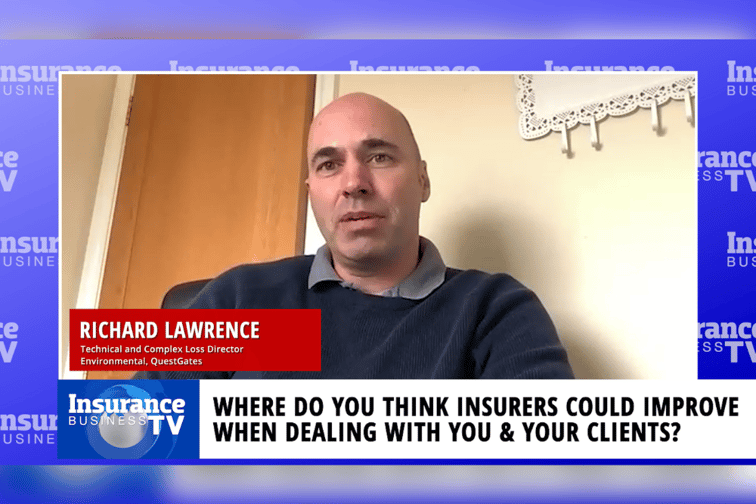

With the right team assembled it is amazing how much information can be disseminated in less than an hour, as proven by Insurance Business’s recent ‘Environmental insurance’ roundtable which saw a panel of top brokers answer the most pressing questions surrounding the coverage.
Examining the role that strong insurer partnerships play in creating a healthy insurance ecosystem, Richard Lawrence (pictured), technical and complex loss director, environmental at QuestGates emphasised that, from a claims perspective, the important thing is to understand the insurer’s claims philosophy, as well as what is or isn’t covered under the policy.
This is particularly helpful when it comes to environmental claims where urgent action is often needed at the outset of the claim, he said, so understanding what is covered is key to managing the expectations of all relevant stakeholders. In the past, a lack of understanding about this sector has been an issue due to the small number of claims professionals who have experience in dealing with environmental claims.
“So, what we’ve tried to do and what insurers certainly have taken on board, is having training delivered by ourselves and also by other professionals in the market such as environmental lawyers and consultants,” Lawrence said. “That’s certainly where improvements are being made to the level of understanding and knowledge of environmental claims.”
Duncan Spencer, director at EDIA Limited stated that, from a broking perspective, there are two phases within a policy – negotiating the initial policy and then the policy’s lifetime. A strong insurer relationship, therefore, centres on easy access to the underwriter when questions and issues arise or additional flexibility is required. It’s not always about price, it’s also about response times, not just on the underwriting side but also with regards to the policy wording and the legal support needed to amend the policy.
“And then on the claim side, it’s great to have people like Richard involved in our market because having great claims handling is what the policy is for,” he said. “And when we start looking at complex claims, where at the point of notification, it’s not an emergency, we just know there’s a liability coming out over the hill – we need to be able to connect with a claims manager at the underwriter who’s open-minded. At the outset, we don’t want them to say the claim is not covered or that it is covered, we just want them to say ‘keep it coming and we’ll try and work through this with you.’”
That flexibility is essential, Spencer said, and he has seen service levels across the sector improving as the market is developing as, with more claims coming through, claims departments are gaining valuable experience.
Of course, insurers aren’t the only game in town when it comes to environmental insurance coverage and the question for many brokers is whether there are cases in which it might be more beneficial to use an MGA instead of an insurer. Commenting on this, Judith Golova, head of environmental insurance at Marsh, stated there is definitely scope for MGAs to play a role, particularly when certain portfolios of risk are fairly straightforward or even fairly low risk.
Golova has seen MGAs for petrol station portfolios and for farming risks, and she noted that Marsh runs the MGA Victor which deals with pollution risks for farmers. This is a fairly low premium, low touch space that it’s easy to collect data for, she said. Generally, it is in such spaces with a limited scope and complexity, where a less complete package of coverage is required, that MGAs tend to operate.
“Now, some MGAs are not true MGAs,” she said, “because the underwriter still does the underwriting. But MGAs are sometimes kind of halfway there where they do the data collection in a particular format for the underwriter. And generally speaking, I think that the speakers that we have in the room at the moment are very used to dealing with more complex environmental risks where the scope of an MGA might be quite limited.”
James Alexander, environmental practice leader at Lockton Companies agreed that MGAs are more suited to lower risk profiles and more homogenous sectors such as real-estate related risk and indemnification at transaction point. Quite a few capacity providers are backing MGAs that are putting environmental components into the real estate and property transaction space. Where you have a fairly homogenous portfolio of multiple small exposures, and a reasonably short time horizon of perhaps three to 10 years, MGAs can work very well, he said.
“Many MGAs are of course reinsuring on the backside,” he added, “and so reinsuring their longer tail risk, and a lot of this MGA appetite is capacity deployment. So, I do agree with Judith but I’m accutely aware that selecting the appropriate carrier for the risk is the most appropriate thing. Because if the insurance is underpinning a financial provision, or is relating to a permitted activity, then it’s under much more scrutiny than an individual isolated little site within a massive portfolio. But MGAs have their place. It’s just a matter of choosing where that place is.”
